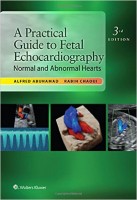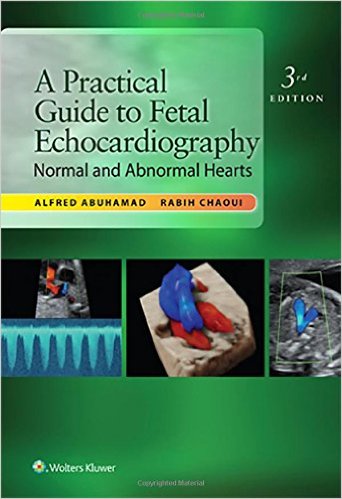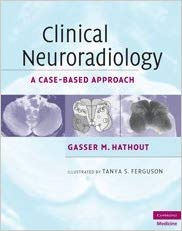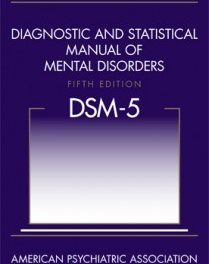 Authors: Alfred Abuhamad, MD; and Rabih Chaoui, MD
Authors: Alfred Abuhamad, MD; and Rabih Chaoui, MD
Publisher: Wolters Kluwer | Lippincott, Williams & Wilkins – 593 pages
Book Review by: Hiro Motiram
This is a unique, highly informative, very practical, and extremely useful volume on diagnosing the hearts of unborn and newborn infants, both in good condition and defective, with numerous illustrations and other study aids such as charts, photos, radiographs, ultrasound, and other types of images.
Congenital heart diseases (CHD), also known as congenital heart defects, are common forms of severe congenital abnormalities. Half of such cases are minor, and are easily corrected through surgery. But the other half account for more than 50 percent of deaths from congenital abnormalities in childhood, Drs. Alfred Abuhamad and Rabih Chaoui point out in the first chapter of this book on the incidence, risk factors and prevention strategies for such anomalies.
The two main CHDs common in premature infants are: patent ductus arteriosus and ventricular septal defects. There are about eight to nine cases of CHD per 1,000 live births. Nearly half – 46 percent – are discovered in the first week of life; 88 percent by the first year; and almost all – 98 percent – by the fourth year of a child’s life.
CHD is a problem in the structure of the heart of an infant at birth. Symptoms range from none to life-threatening. They include bluish skin, feeling tired, poor weight gain, and rapid breathing. Causes of CHD? Alcohol and tobacco use by the mother, infections during pregnancy, poor nutrition, and obesity are the most common known ones.
CHDs are of two basic types: cyanotic and non-cyanotic, which depend on whether the child has the susceptibility to turn bluish in color. They are related to the interior walls of the heart, the heart valves, and the large blood vessels that lead from, and to the heart.
Some genetic conditions have also been associated with heart defects, such as Down syndrome, Marfan syndrome, and Turner syndrome. Research is ongoing on other effects of congenital heart disease and relationships between it and other medical problems among children.
This book helps you, the practicing specialist, resident, or student in fetal cardiology, learn more about the following topics, among many others:
- Cardiac embryology
- Discussions of fetal cardiac malformations
- Enhanced cardiac examination of the unborn and the newborn, including color and pulsed Doppler and use of three-dimensional ultrasound
- Fetal cardiac screening – international and U.S. guidelines
- Genetics of cardiac function and malfunction
This third edition of the book, with a 2016 copyright, aims to provide up-to-date information on the subject of cardiac imaging of unborn humans. Fetal echocardiography is a rapidly-evolving field, the authors point out, so if there are developments that occur not found in this print version, we urge readers to register this book and themselves on the website of the publisher we provide below, where you can also access content not found in the physical book.
Below we provide you with an overview of what you will find in this outstanding book of 33 chapters entirely developed, organized and written by two obstetricians:
- Congenital Heart Disease: Incidence, Risk Factors, and Prevention Strategies
- Guidelines for the Performance of Sonographic Screening and Echocardiography Examination of the Fetal Heart
- Embryology of the Heart
- Genetic Aspects of Congenital Heart Disease
- Cardiac Anatomy
- Fetal Situs
- Cardiac Chambers: The Four-Chamber and Short-Axis Views
- The Great Vessels: Axial, Oblique, and Sagittal Views
- The Three-Vessel-TracheaView and Upper Mediastinum
- Systematic Evolution of the Venous System
- Organization of the Two-Dimensional Grayscale Image in Fetal Cardiac Examination
- Color Doppler in Fetal Echocardiography
- Pulsed Doppler in Fetal Echocardiography
- Fetal Cardiac Function
- Three- and Four-Dimensional Ultrasound of the Fetal Heart
- Fetal Cardiac Examination in Early Gestation
- Fetal Cardiac Measurements and Reference Ranges
- Atrial, Ventricular, and Atrioventricular Septal Defects
- Univentricular Atrioventricular Connection, Double Inlet Ventricle, and Tricuspid Atresia with Ventricular Septal Defect
- Ebstein Anomaly, Tricuspid Valve Dysplasia, and Tricuspid Regurgitation
- Aortic Stenosis and Bicuspid Aortic Valve
- Hypnoplastic Left Heart Syndrome and Critical Aortic Stenosis
- Coarctation of the Aorta and Interrupted Aortic Arch
- Pulmonary Stenosis, Pulmonary Atresia with Ventricular Septum, and Ductus Arteriosus Constriction
- Tetralogy of Fallot, Pulmonary Atresia with Intact Ventricular Septal Defect, and Absent Pulmonary Valve Syndrome
- Common Arterial Trunk
- Double Outlet Right Ventricle
- Complete and Congenitally Corrected Transposition of the Great Arteries
- Right Aortic Arch, Double Aortic Arch, and Aberrant Subclavian Artery
- Fetal Heterotaxy and Situs Inversus
- Anomalies of Systemic and Pulmonary Venous Connections
- Fetal Cardiomyopathies and Fetal Heart Tumors
- Fetal Arrhythmias
The entire contents of the print edition are available for download as an eBook. Follow these simple steps:
- Go to http://solution.lww.com/access
- Enter the Access Code found on the inside front cover of this book
- Enter your information, click Submit, and follow the on-screen instructions to start reading your eBook
Your book purchase includes not only a complimentary download of the enhanced eBook for iOS, Android, PC and Mac, but also these features:
- Complete content with enhanced navigation
- Powerful search tools and smart navigation cross-links that pull results from content in the book, your notes, and even the web
- Cross-linked pages, references, and more for easy navigation
- Highlighting tool for easier reference of key content throughout the text
- Ability to take and share notes with friends and colleagues
- Quick reference tabbing to save your favorite content for future use
This is a highly useful book on fetal echocardiography.
Authors:
Alfred Abuhamad, MD is Professor of Obstetrics & Gynecology, and Professor of Radiology; Chairman of the Department of Obstetrics & Gynecology, and Vice Dean for Clinical Affairs at Eastern Virginia Medical School in Norfolk, Virginia.
Rabih Chaoui, MD is Professor of Obstetrics & Gynecology at Prenatal Diagnosis and Human Genetics Center in Berlin, Germany.







